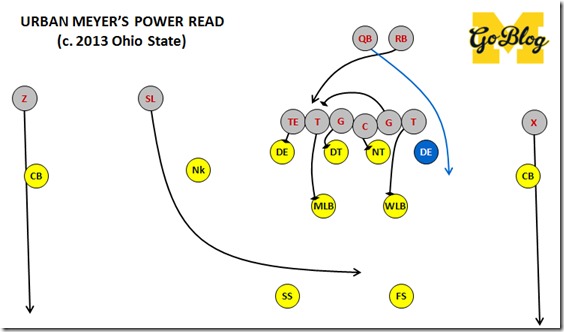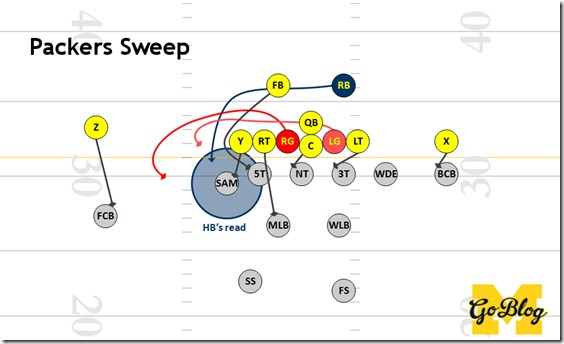
This was boss by James Ross. Read on to find out why it was pretty cool of Mattison too.
In football everything old tends to become new again. In last week's article on the Saban pattern-matching defense I alluded to how Alabama tried to use the same strategy Virginia Tech had against Ohio State, and got "85 Yards Through the Heart of the Southland" in their face. However Michigan had some success last year defending this same stuff from a base alignment. So I thought I'd explain how.
Tech refresher
A quick refresher on what "3T" and "2i" etc. mean: A "technique" is the place a defensive lineman lines up relative to the offensive linemen:
When we say Willie Henry is a perfect 3-tech, it means he's good at doing things that you would do if you're usually lining up on the guard's outside shoulder.
They are numbered more or less from the inside out, but it gets confusing from having amalgamated many different coaches' terms for where a defender's hat starts. Like how a baseball diamond can comfortably accommodate all four sexual acts you knew of in 3rd grade, but once you're deep into high school extending the analogy leads to a lot of weirdness and disagreement.
Notice that there aren't names for lining up directly in a gap; you want your lineman to be "covering" (lined up in front of) someone to some goodly degree because in any scheme delaying an offensive lineman from getting downfield is a win for the defense. This will be important in a bit, but first let's talk about what OSU does.
Meyer's Base
By now I figure you know what the zone read looks like. Meyer does zone—and did so a lot more with zone guy Tom Herman at the helm than the heavy power stuff he ran at Florida—but at his heart he's still a Manballer. He manballs with the read-option…
…and he Manballs with regular old Power O from his spread sets. Here's what that looks like:
This was the same running game they used to pound defenses to death with Carlos Hyde, using the constant threat of Braxton Miller loping around the backside if you attacked that by crashing the middle, and dangerous vertical threats running downfield if you activate your safeties against it.
If Brian had UFR'd this I imagine he'd ding Glasgow –2 for getting blown five yards downfield by the double (and the refs for Mone getting held but that rarely gets called). Bolden had to watch for a backside cut but his path to the ball was blocked by Glasgow. The hold meant Mone couldn't fight off his block to stop the puller from getting into the lane, and Ryan can only pop that guy to restrict the hole.
But back up; why did such a good running offense need a hold and a good NT getting blown off the ball to gain its yards? Michigan made this hard by having two defensive tackles lined up over the guards. If Mone and Glasgow could hold their ground, Ryan and Bolden have a chance to stop this for a minimal gain. Two plays later they would, and it goes back to what Virginia Tech is doing with the old Bear.
[After the jump]
Stuffing It With G and Bear
What Virginia Tech did is they took away Ohio State's favored inside running game by covering the guards. The Hokie defense has been covered in detail by various sites, and getting into all the ways they use these fronts is beyond the scope of this piece.
The bit you need to know is they have two basic fronts they can switch between—often right before the snap—and both have line defenders over the guards.
The G front is the safer base thing; the guards are covered but it's only a slight cheat to pinch off B gap running attacks. It's nice against the spread because it's not easy to run A gaps with a shotgun RB—the back would have to stop and cut back to get to it. Going Bear, i.e. Buddy Ryan's 46 defense from the 1970s-80s Chicago Bears, is more aggressive; you're overwhelming the interior blocking.
The spread adjustment is that hybrid space player (VT's term "Rover" comes directly from the old 4-4 defenses that spun off Buddy Ryan's 46 defense, i.e. the Bear). The rover will line up to whichever side has the most receivers, i.e. the side with the slot (link to 2x2 look). Because the Bear is packing guys into the middle, there ain't nothing coming that way.
How did that beat the Buckeyes? Because Urban's base offense is all about running the ball into the B gaps for six yards a pop; all the fancy higgly wigglies are about letting him do that without the defense doing things that overcompensate for it. If your base is beating that base, then you're all up in Urbz's base.
Out-Flanking the Bear
A coach as diabolical as Meyer can be expected to adjust and adjust he did. If Bud Foster was gonna show the world how to beat Ohio State with the 1985 Bears, Urban was gonna reach back further and pull out some serious Vince Lombardi shit.
The Green Bay power sweep could be run against any front—they called "even" or "odd" at the line and everybody's role adjusted based on that. It was a simple play that got very complicated by each player having myriad pre- and post-snap adjustments he'd make to whatever the defense does. But once all those things were taught it was dynastic; like the spread offense it let the defense pick its poison every play, and all the offense had to do was attack wherever the hole opened.
If Power from above is the Manball version of Inside Zone, the Packer Sweep is the manball version of the Zone Stretch; the play strings along outside until a lane is found.
What's nice about the sweep against G and Bear defenses is those covered guards aren't releasing downfield. I didn't show it well in the old diagram above but the receivers run slant routes, walling off the cornerbacks if the cornerbacks do the usual coverage thing, or getting in position to crack one of the inside defenders if the CB blitzes or runs inside.
It was a Packer Sweep's cracking receiver against a hybridized linebacker pinching in against an interior run that sprung the famous 85-yards through the South play. But in the Ross is Boss gif, even with a flexed tight end doing the cracking, they got no such love.
The other nice thing about about the sweep is you can call it against any alignment. Remember this.
Flucking Flank
After the first down resulting from the Power run by Ohio State I showed above, Matt Godin had one of his best plays as a Michigan lineman, beating a blocker to nearly sack Barrett and force a throwaway. On the next play, the rare Ohio State 2nd and 10, Urban decided he'd try the flanking maneuver. Here's his play:
(not sure on alignment of Z; it doesn't matter for this play)
It's an unbalanced formation (the Y tight end is covered by the X receiver), and a pin and pull—a cousin of the Packers sweep. You'll note that rather than two guards pulling the center and right tackle are doing so. The tackle, rather than a guard, pulled in the Power example as well. This is by alignment; the center can't block Mone from where he starts so the play moves one down. I believe that's an adjustment Urban made to his offensive line last year—the guards were young while the OTs were both seniors and the center was the last of Mike Boren's disappointing spawn.
Michigan was in its standard 4-3 over front. But after the snap there's a twist:
Remember a few paragraphs ago when I told you to remember the thing about calling the play based on the defense's alignment. This totally screws with that: by slanting a gap over with the DL, all of the adjustments OSU made at the line are now incorrect.
They may not have lined up in a Bear, but the slant ends up accomplishing much the same thing: crash into those guards so they can't get downfield, put speedy linebackers at the point of attack, and jam the edges with strong run defenders. Had this been another inside thing you have Jake Ryan attacking one B gap and Taco Charlton shooting into the other. But this isn't inside; it's the Packer Sweep thing. Well…
The tight end got his crack on the MLB (Ryan) that the playcall gives him, but by going inside Jarrod Wilson was freed to put his eyes on the run and shoot up into the flats—if Ross doesn't end this himself Wilson was ready to clean up.
Ross destroyed this by whacking the pulling RT so hard the dude bounced into Elliott's path. Ross then was free to corral the running back. First this is an excellent individual play by Ross in his 4-3 over role as quasi-hybrid space player. He had the linebacker's strength to blow up a 5th year senior OT, also the speed to not get instantly beat around the edge by one of the faster guys in the conference, and also the body agility to square up when Elliott did and kill this for no gain. Second, this was set up by the play design that took away both Ohio State's base, and its counter, and let a clean linebacker play aggressively against he run.
The danger of course was a deep pass, since our guys would be on their deep threats with a lot of space (the free safety came over with the RB but Jeremy Clark isn't rangy enough to get to the corner of the end zone before Devin Smith). On 2nd and long it was a calculated risk that Meyer would want to get back on track with something that sets up 3rd and makeable. Instead it's 3rd down and another weirdly close Game against a clearly less talented Michigan.
What does it mean for this year? Michigan returns an excellent trio of linebackers, plus a game-changing safety/hybrid space player in Peppers. At least one cornerback should be able to hold his own against any receiver in the league, and the other cornerback is either senior Blake Countess or a guy who beats senior Blake Countess. Jarrod Wilson is now free safety instead of Clark. And while the DE positions are questionable the interior DL is a strength. Michigan appears the horses to do some Bear this year without getting burned. And Bear is fun.



